One fish, ten fish, big fish, Zen fish. That’s how Theodor Geisel—Dr. Seuss from our child- and parenthoods—might have described the fly-fisher’s journey. In his excellent essay, “The Five Stages of Fly Fishing,” Todd Tanner includes another phase between big and Zen, something Seuss might have called finicky fish. This stage is when that fish—the one that sips unrecognizable flies from an inaccessible lie—is the only fish we want to catch. We change flies, extend leaders, and push our casting skills against their ceiling, but—like Seuss’s North-Going Zax—that fish refuses to change its ways. In defiance, we stand there like the South-Going Zax and fish until the entire world stands still.
For many of us, these stages link sequentially, like a prerequisite chain in education. First, we need to catch a fish, then a lot of fish, then some big fish, and finally, we need to catch that fish. Nothing as dramatic as Norman’s Walter from On Golden Pond, but a fish we think might change our lives in some meaningful way. When we reach the end of this chain, need often gives way to want, and what we want is only to go fishing and, perhaps, watch someone else—a daughter, a son, a friend, or a stranger—catch a fish, a lot of fish, a big fish, or even that fish.
Like much of life itself, most chains have a beginning, a middle, and an end. Regarding this progression, Thomas Wolfe told us we couldn’t go home again, and Heraclitus said we couldn’t wade in the same river twice. But the fly-fishing chain is not so rigid, and we fly fishers can go back, especially if we blur the distinction between place and experience. After years of fishing, we can still catch a new fish in a new river, land a big fish in a small stream, or hook ten fish when we expect only one. And that fish can show up just about anywhere and anytime.
Here in Montana, I’m jumping from link to link like a frog in a thunderstorm. Yesterday, I caught my first fish in a Montana river. Then I discovered, hooked, and lost that fish on the Beaverhead. I landed several big fish with a bobber and a nymph this morning. Now I’m not sure what I want, but I know I want to find it in the Big Hole River. I’ve never caught a whitefish or a grayling, and they live here. And when I told Jerry Kustich I had landed a small brown, brook, and rainbow trout on my first day on the Big Hole, he said, “Don’t let that fool you. There are big fish up there.”
Fishtrap Creek flows into the Big Hole River halfway between Divide and Wisdom. There’s a state campground where the creek joins the river and another campground—called Sportsman’s—about three miles downstream from that. The campsites at Sportsman’s are right on the river, so I pull in and check one out. The campground host tells me the camping is free, but they’d accept a donation if I want to give them one. I do. Several trailers and motor homes populate the main campground, but I’m the only one camping along a small gravel road that parallels the river, just to the west of the riverside hamlet. I park my truck, eat a late lunch, and then nap.
I wake up, pull on my damp waders, and wade into the river. Some brook trout feed on tiny insects when the sun hides behind a cloud. The dimples they leave on the river’s surface prompt me to cast. I can’t tell what bugs they’re eating, but brook trout aren’t known for their discerning taste, so I tie on a size 18 Borchers Drake. None of the Montana fly shops I’ve visited carry this pattern. It’s a Michigan fly created by an Au Sable River guide named Ernie Borchers to imitate the burly brown-drake mayflies. It works well in small sizes and in other states too, and when the tiny fly floats without dragging over one of these Montana brook trout, they attack it. None of the trout I catch are trophies—by Montana standards. But by the benchmarks of Michigan’s small Upper Peninsula streams, they are excellent fish.
In Brook Trout and the Writing Life, Craig Nova writes of how the sides of brook trout have “a line of bright circles which are red or orange and bright, and they have the aspect of sequins, of a silver maple leaf in late fall.” How, I wonder, can something as wary as a brook trout display such color on its body? The pale yellow freckles against the brownish-green hue of their skin fashion a sort of camouflage. But—to all the predators in the river—the gleaming red blotches encircled by brilliant blue halos seem to scream, “Hey, look at me!” Not getting eaten, though, is only part of the evolutionary game. The other part is finding the best mate, and—like the lavish tails on a peacock or a five-hundred-dollar Stefano Ricci silk tie—those spots might also say, “Look at me. I’ve got the right stuff.” The spawning season has a way of bringing out the garish in all of us.
When the light dips below the hills and a single shadow blankets the water, I see a larger fish feeding behind a rock. A splashy commotion reveals each rise: the fish grabs the fly; its back breaches the surface; its tail froths the water. When I make a good cast and presentation, the fish rises to the fly, but I don’t hook it. The trout missed, I think. But the trout never misses the real flies. My fly is probably too large, so I change to a smaller pattern. Yet I still can’t catch it. I ensure the hook is intact and check its point on the nail of my thumb. Everything appears to be okay, so I make another cast. Finally, the fish rises to the fly, the bamboo rod arcs, and I hurry to get the excess line on the reel. I’ve got a big trout, I think.
At first, the fish swims toward the island and I follow. The bottom isn’t as slick as it was in the other places I’ve been on the Big Hole. But still, I move like a high-wire artist performing without a net. When the fish rolls and flops like a walleye, I’m convinced it’s a large brook trout—possibly the largest I’ve ever caught. Then I see a red spot on its gill plate—the kind you see on a rainbow trout—but notice something peculiar about its body shape. Unlike a rainbow, this fish looks like a giant version of the minnows we used to pull from the Styrofoam bait bucket. When I get the fish close enough, I dip my net under its body. It’s a Montana whitefish.
The whitefish tires quicker than a trout of its size would, but—once I have it in my net—it bucks like a Charbray bull. Fifteen inches of bone, muscle, and gristle make getting the hook out of its tiny sucker-style mouth nearly impossible. The river’s surface is now boiling with rising fish. With the new patience I learned from the first whitefish, I catch four more, two of which suck the fly so deep in their mouth I have to cut the line. When it’s finally too dark to fish, I return to the Suburban and make a chicken salad sandwich. I hear a few fish rising directly in front of my campsite, but I don’t want to catch another whitefish. I’m content to sit at the picnic table and drink a Two-Hearted Ale.
I’ve heard some Montana trout anglers treat whitefish with the same violent disdain as some Michigan steelhead anglers reserve for suckers. I’ve seen the banks of a heavily fished Great Lake tributary lined with the corpses of redhorse, longnose, white, and other species of sucker. Some with a hook still in their mouth, having been interred into their grassy grave with a kick strong enough to snap the line. Montana whitefish sometimes meet with a similar demise. Like the suckers, the whitefish’s capital crime isn’t being who they are but simply being who they aren’t. I have a list of fish I want to catch in Montana, and the native whitefish is on it. So I’m proud to put a check beside its name.
Back at my truck, I lower the windows far enough for the river to sing me to sleep but not so far that a bear might reach in and pluck me out like a pickle from a jar. When I wake, a misty veil of fog blankets the river. I get out of the truck and look for paw prints but find no signs that a bear had visited in the night. I want to see some different scenery this morning, so I drive to the access near Fishtrap Creek. Boulders the size of refrigerators and ovens line the bank on my side of the river, and a mountain rises from the far shore, shading the water from the sun’s first light. I sit on a sofa-sized rock and eat a cup of yogurt for breakfast.
When the Trico hatch is on, clouds of tiny flies will hover above the river. I drive along the highway, looking for those clouds, but the air is clear. It must be a few days too early still. When I drive over a bridge, I see hundreds of swallows dancing and darting like Messerschmitts in a dogfight. But they’re not fighting each other; instead, they’re in hot pursuit of tiny flies. I park beside the river, and the water is thick with rising fish in the bridge’s shadow. More whitefish, I suspect, and even though I thought I was finished with whitefish last night, I pull on my waders and tie on one of the small purple mayflies I bought in Livingston. As expected, I don’t hook the first fish that rises to my fly. I need a slight hesitation to catch these whitefish. So I whisper God Save the Queen before setting the hook on the subsequent rise. The fish is powerful. It hauls the loose line from the river when it swims for the deepest water under the bridge. “A big whitefish,” I think. All the whitefish I caught yesterday had three stages of their fight. First, they bolted from the scene. Then, after a brief struggle, they went lifeless like a waterlogged stick, saving their energy for the final stage of bronco bucking in the net. This one doesn’t enter stage two, and when it jumps from the river, I see a rosy spot on its gill plate and a spicy pink stripe along the entire length of its body. It’s a rainbow trout and a large one at that. There’s a lot of moss in this section of the Big Hole River, and the rainbow wraps several globs of this stuff around my line, causing me to worry that the added weight will impede the rod’s ability to protect the tippet. But, somehow, I land this trout with about a pound of moss. I release the fish on the edge of the bridge’s shadow, and when it swims into the light, its namesake stripe ignites into a brilliant fire-red.
I catch three more nice brook trout. Again, these are fine fish by Big Hole standards, but they’d be trophies by my small-stream, home-water benchmarks.
And then it happens. I see that fish rising next to one of the bridge’s piers. It’s a large brown trout, porpoising just like the one on the Beaverhead two nights ago. I’m not as nervous as I was then, but I don’t have the steady hands of a jeweler, either. My first two casts are short. The fish either doesn’t see the fly or doesn’t want to move to get it. When I cast to the right spot, the trout comes up for the fly, then pushes it to the side with its nose. It happens again, so I replace the little purple fly with a size 18 Roberts Yellow Drake, another Michigan fly that works well for picky fish. When the fly lands about three feet above the trout, I hold my breath as the yellow imposter drifts naturally toward the target. The big trout eats the fly without hesitating. I lift my rod too fast and too hard. The tippet snaps, and that fish is gone.
The birds have returned to roost under the bridge, and all the fish have stopped rising. There are no more flies for either of them to eat. The Tricos probably won’t hatch reliably for another day or two, so I reconsider my options. I could drive to the Ruby River, Poindexter Slough, or back to the Beaverhead. I’ve only peeled the outer layer off those onions. As an alternative, Jerry told me about another river named Rock Creek. He said I could get there by taking Chief Joseph Pass from Wisdom, then following Highway 93 north along Camp Creek and the Bitterroot River. Much like gravitational fields keep the planets in orbit, some invisible force at a distance draws me toward fresh adventures. Rock Creek will be the next stage of my trip.
"Stages" is an excerpt from the book, A Cast Away in Montana, from longtime and frequent Hatch Magazine contributor Tim Schulz. The book was released on May 7, 2024 and is now available to order through Amazon. To order a copy signed by Tim, as well as renowned painter Bob White, whose artwork graces A Cast Away in Montana, visit Bob White Studio.





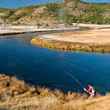

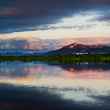


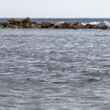



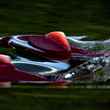




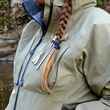




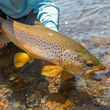



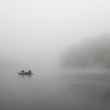

Comments